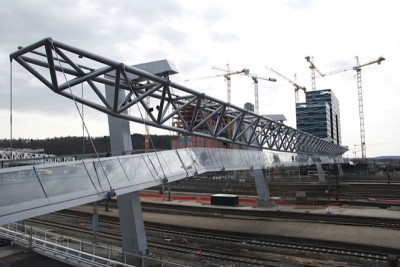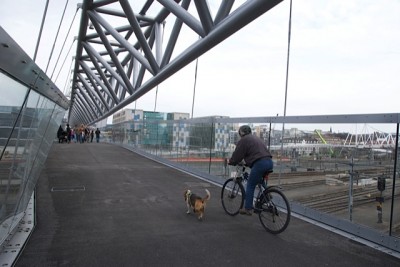A bold new pedestrian bridge over the vast expanse of railroad tracks at Oslo’s Central Station opened over the weekend, to literally bridge the gap between one of the capital’s oldest and poorest neighborhoods with one of its newest and most affluent. Real unification may take some time.

On the one side, north of the tracks, is Oslo’s Grønland district, long a working class and semi-industrial area. It underwent a mixture of renewal projects in the 1980s and early 1990s, attracted a large Middle Eastern and south Asian population and now is in the midst of further gentrification with new restaurants and galleries, for example, opening all the time.
On the other side, south of the tracks and closer to the waterfront, is the industrial and, in some areas, most historic parts of Oslo known as Bjørvika. It was the site of some of the capital’s earliest Viking settlements and later the churches and dense community that existed during the Middle Ages, until the city was moved to the other side of the bay behind the Akershus Fortress and Castle. Bjørvika then became an industrial harbor area and, eventually, the location of the main highway through Oslo.

It since has been a target of the city’s major waterfront redevelopment plans, anchored by the new Opera House and soon to feature high-rise office and condominium buildings in a strip known as the “Barcode.” The highway has been replaced by the new Opera Tunnel under the fjord, and it will eventually be the site of quieter streets, more commercial and residential developments and, if city officials get their way, a new Munch Museum and city library.
The residences are predictably on the pricey side and critics are already complaining that the fancy new buildings will wall off the waterfront instead of opening it up, and be unaffordable for most. Somehow, though, many of the residential units are already sold, and Norway’s biggest bank, DnB, will move its headquarters to Bjørvika in a few years. Major accounting and consulting firms and the civil aviation authority Avionor have already moved into the Barcode buildings as new tenants.

Yet the railroad tracks divide the emerging redevelopment projects at Bjørvika from the multi-cultural and increasingly popular Grønland district, hence the broad pedestrian bridge that can also be used by cyclists. A second bridge, a bit farther to the east, will accommodate vehicular traffic and is still under construction.
Both are visually impressive and meant to be, to draw attention and be used. The new pedestrian bridge was designed by L2 Arkitekter and stretches from the newly named Annette Thommessens Plass between the new tax office Skatt Ost and another new building that houses, among other things, the police office where all immigrants must regularly report to receive and renew their residence and working permission. It’s only fitting that the plaza between them and leading to the bridge was named for one of Norway’s leading advocates for asylum seekers.

“It looks just fantastic,” Tina Holth, an artist active in the area, told newspaper Dagsavisen. Even though she thinks it’s sad that some of the old industrial buildings and waterfront warehouses are disappearing, she thinks it’s “great that pedestrians and cyclists get this new bridge, it’s beautiful and it’s impressive.”
Oslo Mayor Fabian Stang formally opened it Saturday afternoon, with ceremonies featuring outdoor entertainment, refreshments and distribution of a map of the area with suggestions for a cultural walking tour of the two neighborhoods. Curious Oslo residents were still wandering around on Sunday, including former top Oslo politician Erling Lae, who now is county administrator in Vestfold. He was among the initiators of Oslo’s waterfront redevelopment, and he was smiling as he checked its status.
Views and News from Norway/Nina Berglund
Join our Reader response forum if you’d like to comment on this story. Reader response

